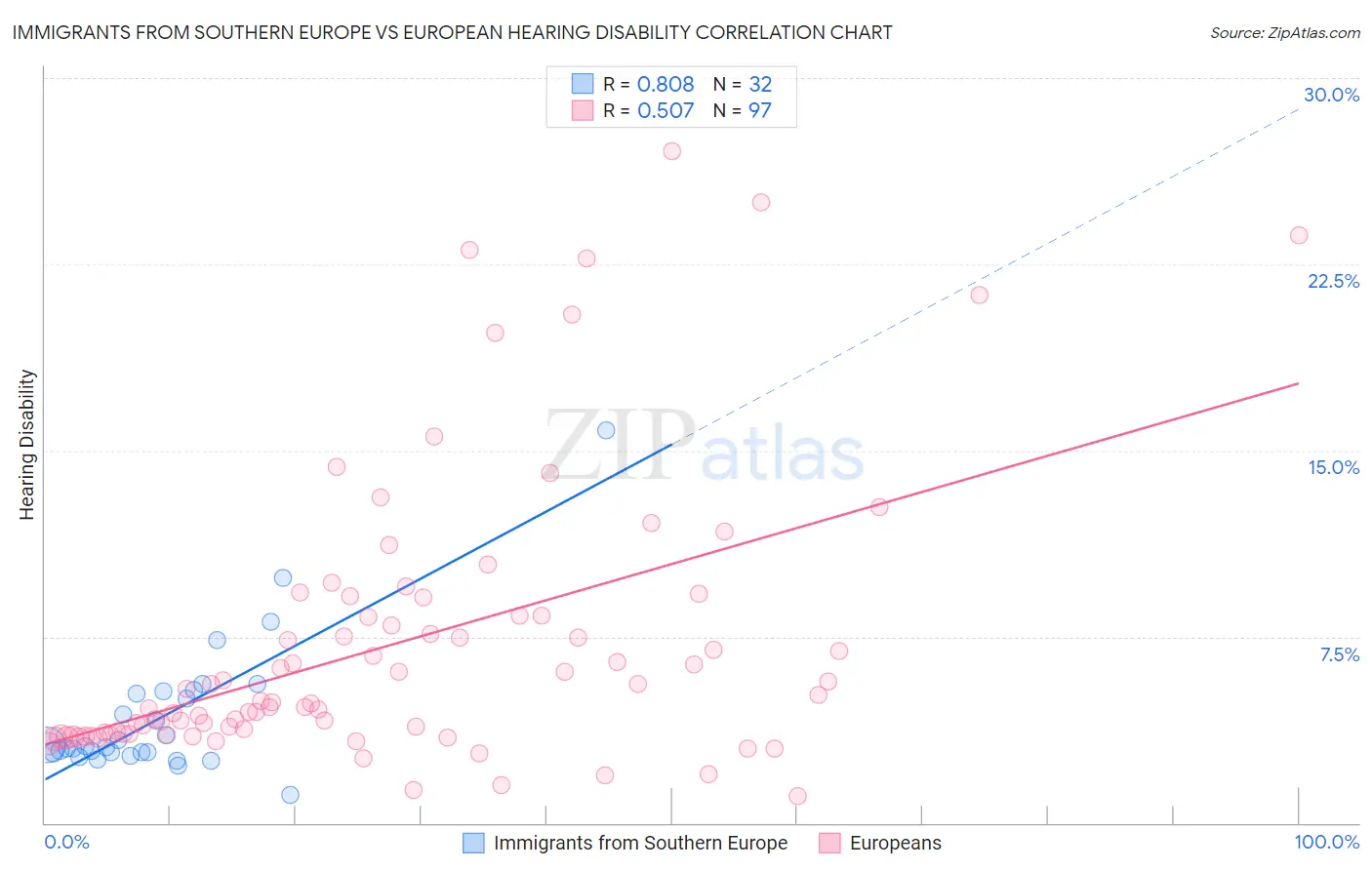Immigrants from Southern Europe vs European Hearing Disability
COMPARE
Immigrants from Southern Europe
European
Hearing Disability
Hearing Disability Comparison
Immigrants from Southern Europe
Europeans
3.0%
HEARING DISABILITY
35.3/ 100
METRIC RATING
185th/ 347
METRIC RANK
3.5%
HEARING DISABILITY
0.1/ 100
METRIC RATING
270th/ 347
METRIC RANK
Immigrants from Southern Europe vs European Hearing Disability Correlation Chart
The statistical analysis conducted on geographies consisting of 402,653,873 people shows a very strong positive correlation between the proportion of Immigrants from Southern Europe and percentage of population with hearing disability in the United States with a correlation coefficient (R) of 0.808 and weighted average of 3.0%. Similarly, the statistical analysis conducted on geographies consisting of 561,261,732 people shows a substantial positive correlation between the proportion of Europeans and percentage of population with hearing disability in the United States with a correlation coefficient (R) of 0.507 and weighted average of 3.5%, a difference of 15.6%.

Hearing Disability Correlation Summary
| Measurement | Immigrants from Southern Europe | European |
| Minimum | 1.1% | 1.1% |
| Maximum | 15.8% | 27.1% |
| Range | 14.7% | 26.0% |
| Mean | 4.3% | 7.2% |
| Median | 3.1% | 4.8% |
| Interquartile 25% (IQ1) | 2.8% | 3.6% |
| Interquartile 75% (IQ3) | 5.3% | 8.3% |
| Interquartile Range (IQR) | 2.4% | 4.8% |
| Standard Deviation (Sample) | 2.8% | 5.6% |
| Standard Deviation (Population) | 2.8% | 5.6% |
Similar Demographics by Hearing Disability
Demographics Similar to Immigrants from Southern Europe by Hearing Disability
In terms of hearing disability, the demographic groups most similar to Immigrants from Southern Europe are Immigrants from Mexico (3.0%, a difference of 0.050%), Black/African American (3.0%, a difference of 0.060%), Mexican American Indian (3.0%, a difference of 0.070%), Immigrants from Ireland (3.0%, a difference of 0.21%), and African (3.0%, a difference of 0.25%).
| Demographics | Rating | Rank | Hearing Disability |
| Japanese | 46.0 /100 | #178 | Average 3.0% |
| Immigrants | Moldova | 43.1 /100 | #179 | Average 3.0% |
| Immigrants | Sweden | 42.4 /100 | #180 | Average 3.0% |
| Immigrants | Belgium | 41.5 /100 | #181 | Average 3.0% |
| Immigrants | Italy | 41.1 /100 | #182 | Average 3.0% |
| Bulgarians | 39.7 /100 | #183 | Fair 3.0% |
| Immigrants | Ireland | 37.4 /100 | #184 | Fair 3.0% |
| Immigrants | Southern Europe | 35.3 /100 | #185 | Fair 3.0% |
| Immigrants | Mexico | 34.9 /100 | #186 | Fair 3.0% |
| Blacks/African Americans | 34.7 /100 | #187 | Fair 3.0% |
| Mexican American Indians | 34.7 /100 | #188 | Fair 3.0% |
| Africans | 32.9 /100 | #189 | Fair 3.0% |
| Immigrants | South Africa | 31.1 /100 | #190 | Fair 3.1% |
| Immigrants | Switzerland | 28.8 /100 | #191 | Fair 3.1% |
| Koreans | 27.6 /100 | #192 | Fair 3.1% |
Demographics Similar to Europeans by Hearing Disability
In terms of hearing disability, the demographic groups most similar to Europeans are Czech (3.5%, a difference of 0.26%), Ute (3.5%, a difference of 0.35%), Fijian (3.5%, a difference of 0.52%), Puerto Rican (3.5%, a difference of 0.59%), and Spaniard (3.5%, a difference of 0.65%).
| Demographics | Rating | Rank | Hearing Disability |
| Immigrants | Canada | 0.1 /100 | #263 | Tragic 3.5% |
| Immigrants | Germany | 0.1 /100 | #264 | Tragic 3.5% |
| British | 0.1 /100 | #265 | Tragic 3.5% |
| Belgians | 0.1 /100 | #266 | Tragic 3.5% |
| Canadians | 0.1 /100 | #267 | Tragic 3.5% |
| Spaniards | 0.1 /100 | #268 | Tragic 3.5% |
| Ute | 0.1 /100 | #269 | Tragic 3.5% |
| Europeans | 0.1 /100 | #270 | Tragic 3.5% |
| Czechs | 0.1 /100 | #271 | Tragic 3.5% |
| Fijians | 0.0 /100 | #272 | Tragic 3.5% |
| Puerto Ricans | 0.0 /100 | #273 | Tragic 3.5% |
| Swiss | 0.0 /100 | #274 | Tragic 3.5% |
| Czechoslovakians | 0.0 /100 | #275 | Tragic 3.6% |
| Danes | 0.0 /100 | #276 | Tragic 3.6% |
| Immigrants | Nonimmigrants | 0.0 /100 | #277 | Tragic 3.6% |